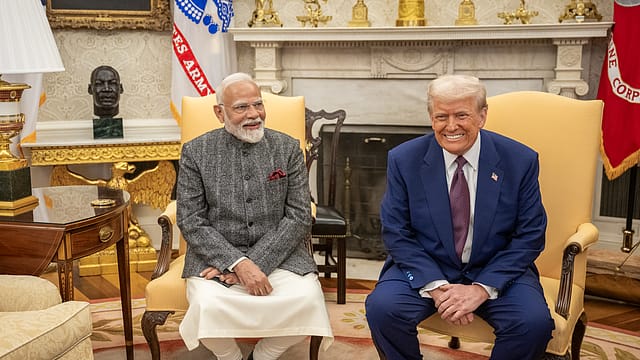As Trump’s April 2 tariff deadline looms, will India escape the impact?
ADVERTISEMENT

On March 29, the representatives of India’s Department of Commerce and the Office of the U.S. Trade Representative (USTR) concluded an initial four-day discussion to chalk out plans for negotiating a mutually beneficial, multi-sector India-US Bilateral Trade Agreement (BTA). The officials decided the next step -- sectoral expert level engagements -- will start virtually in the coming weeks and pave the path for an early negotiating round in person.
In a statement issued after the discussion, the Commerce Ministry said the two sides had a productive exchange of views on deepening bilateral cooperation in priority areas including increasing market access, reducing tariff and non-tariff barriers and deepening supply chain integration in a mutually beneficial manner. However, the significance of the meeting much more than a routine preliminary discussion as happened just days before the unilateral tariff hike or trade war U.S. President Donald Trump has announced to unleash against all its major trading partners on April 2.
The countries whose product exports, at least some of them, will become more expensive due to Trump’s additional tariff include India. The key products that are likely to be impacted in the case of India could be pharmaceuticals, food items etc. Senior commerce ministry officials hope that since India and the U.S have already initiated the dialogue, the U.S may heed to their request to defer the tariff hike against Indian exports to that country. A recent statement from Trump that he will be considering deferment of tariff hike for some countries bolsters this hope. The problem is the unpredictability of Trump’s actions. Even the Indian pharmaceutical industry is on tender hooks. They are visualising multiple scenarios and getting ready to tackle each scenario in the best possible manner.
January 2026
Netflix, which has been in India for a decade, has successfully struck a balance between high-class premium content and pricing that attracts a range of customers. Find out how the U.S. streaming giant evolved in India, plus an exclusive interview with CEO Ted Sarandos. Also read about the Best Investments for 2026, and how rising growth and easing inflation will come in handy for finance minister Nirmala Sitharaman as she prepares Budget 2026.
“There could be tariff rise, it could be moderate, and it could be effective immediately or at a later date. A lot depends on how individual companies decide to respond to the tariff hike. If one company is absorbing the hike and not pass on the price rise to the U.S. customer, competition may have to do the same. If everyone decides to pass on the additional cost, U.S customer will have to pay more. No one can predict the outcome now,” an industry veteran said.
As far as the government is concerned, the question is whether the India-US sectoral talks, especially the talks on the pharma sector, will have to start after the U.S imposes the additional tariff or not. The official statement issued by the ministry after the preliminary discussions concluded last week is silent on this aspect. While it says the India-US talks were conducted with the shared objective of promoting growth that ensures fairness, national security and job creation, there is no mention of its possible impact on Trump’s unilateral decision to slap additional tariffs on import of several products, from countries, including possibly India.
“This talk served as an icebreaker, with substantive negotiations expected to begin later. However, despite the ongoing FTA discussions, the U.S. continues to impose additional tariffs on Indian exports such as steel, aluminium, automobiles, and auto parts. Also, it is not clear, if the FTA talks are about only India making unilateral tariff concessions or US will also cut its tariffs,” Ajay Srivastava, founder, Global Trade Research Initiative (GTRI), New Delhi, says.
According to him, the continuation of these tariffs raises questions about the balance of the negotiations. While both sides engage in dialogue, Washington’s hardline trade stance suggests a disparity in bargaining power. As the talks progress, observers are left to ask: is this a step toward genuine partnership—or just another form of economic pressure?
